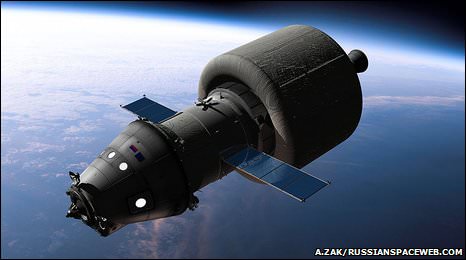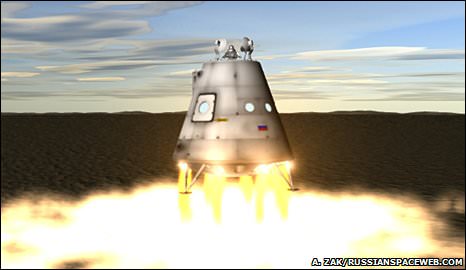[/caption]
Engineers for Russia’s next-generation manned space vehicle are considering a rocket-powered landing system which would provide precision landing on Earth. Currently, the Soyuz uses small solid propellant motors to soften its touchdown, but the ship’s parachute plays the main role in providing the vehicle and crew with a safe landing. Russia is developing a new spacecraft to replace the Soyuz which has been used for nearly forty years. If the rocket-powered landing system is approved, this would be the first time in history that a manned vehicle relied solely on rocket engines for touchdown.
All previous Russian/USSR manned missions have landed on Earth using a parachute, except for the Russian shuttle, Buran, which was never flown to space. made one unmanned spaceflight in 1988. (Early US missions used parachutes, while the shuttle uses wings and wheels to land.)
This change in landing architecture is being considered because Russia is building a spaceport in eastern part of the country that has only a narrow strip of land where spacecraft could land, approximately 2 by 5 kilometers. The new spaceport is a highly political decision, as the current spaceport in Baikonur is located in the newly independent republic of Kazakhstan, and Russian politicians would like to end their dependence and on Kazakhstan for spaceflight.

Therefore, Russian engineers found themselves under political pressure to improve the maneuverability of the next generation spacecraft, so it could guide itself into a relatively small landing area.
Last July, Korolev-based RKK Energia released the first drawings of a multi-purpose transport ship, known as the Advanced Crew Transportation System (ACTS), which, at the time, Russia had hoped to develop in co-operation with Europe.
Combined with retractable landing legs and a re-usable thermal protection system, landing rockets provides the possibility of a reusable capsule as well.
According to the presentation made by Nikolai Bryukhanov, the leading designer at RKK Energia, at the 26th International Symposium on Space Technology and Science in Hamamatsu, Japan, the spacecraft would fire its engines at an altitude of just 600-800m, as the capsule is streaking toward Earth after re-entering the atmosphere at the end of its mission.
After a vertical descent, the precision landing would be initiated at the altitude of 30m above the surface.
The concept looks similar to the US’s experimental DC-X vehicle, tested in the 1990s, which was abandoned at the end of the Cold War.
Source: BBC


Reminds me of the DC-X concept, only without the reuseability bonus.
If control was the problem then they should really be looking at a winged return vehicle or steerable parachute rig (thinking X-38, Dynasoar, etc…).
Rockets have reliability issues and the last thing you want is a capsule full of soldiers plummiting to their deaths because of a faulty igniter.
Also: I wanted to note that the Buran shuttle did fly in space once, but it was unmanned at the time.
Given the past record of technological glitches with Russian space components, I would be highly dubious of totally relying on rockets for a soft landing. Maxwell points out one scenario. What if the capsule is gyrating wildly in that crucial 600-800 meter ignition altitude? How effective would the rockets be in that case?
“If control was the problem then they should really be looking at a winged return vehicle.”
That would be very funny if they adopted a winged vehicle just as we are abandoning ours!
I went to the russianspaceweb.com site and didn’t see anything saying whether or not the aft orbital section is an inflatable module? It kind of looks like it?
Fuel bladder?
Air bags?
It would seem ironic, Pink.
Truth of the matter is that both superpowers have changed their needs in the last 30 years. Now we’re the ones worried about cost and they have the landing space issues.
Ideally a winged runway recovery is the cheapest way to get a ship back. You could bring the thing down on a postage stamp and roll it back to the hangar with just a tow truck.
If not for the shuttles troublesome booster stack we’d be sitting pretty right about now.
I’m sure with enough testing they could make rockets work… but it just seems like there’s too much to go wrong if you ask me.
“I’m sure with enough testing they could make rockets work… but it just seems like there’s too much to go wrong if you ask me.”
Yep sounds a bit hairy. On the upside, it’d give ’em plenty of precision EDL experience that could be used on Mars or other places!
Also, it’s a shame abandoning Baikonur. So much history there in the early days – they were the glory days for Russia, when they were far and away leaders of this whole going to space thing!
Something I would like to know, and I cannot find any info about it:
It’ll be a fiery re-entry. So, how will it get to that point (600 or 800 metres up in the air), slowed down enough to fire those rockets and to achieve a soft touchdown…. all without any aerodynamic lift? I would have expected it to break up before it gets there.
It works on the moon, with no atmosphere to speak of, and wimpish gravity by comparison. But on Earth?
Isn’t there a similar problem with landing “heavy things” safely on Mars?
All current spacecraft use aero braking to return.
With no parachute, a capsule would slow to around 200 mph in the air… Then go splat.
A rocket/airbag combo is good for cargo return missions. Not sure I’d want to ride it tho.
If everything triggers on time, I don’t see a reason it shouldent work. A side advantage (one the dcx could have capitalized on) is it could land on the moon as is. Meaning if they land a return rocket nearby or had a base to shelter in, Russia would be moon ready.
On baikanour, I agree it’s a shame… But why can’t the EU or US buy the facility?
Soyuz is a great backup launcher, and could compete with cots I think.
We the USA done bulit one these, Delta-2 i beleave it was called,a landing leg collapsed an the whole thing fell over an exploded on landing attempt
@HelloBozos:
That would be the DC-X prototype, and the landing leg crash came after several successful test flights. One of which involved a mid flight explosion that it survived.
I actually liked the Delta clipper concept and the test vehicle was impressive for the day. A true Gas&Go rocket that could take off or land anywhere and (in theory, with a refuel) do lunar missions.
The concept survives with Jeff Bezos super secretive “Blue Origin” project.
Personally I think glide return is better for landing on Earth, but anywhere else we go will probably be using rockets.
No way I would ride that. if the rockets are going to fire at 600-800 meters and they don’t, there isn’t much time to do anything about it, really not even enough time to get people on the phone to say goodbye. Too bad they don’t have the advantage of a big, temperate, coastline so they could go the splashdown route.
Actually, all that heating translates into slowing down. You don’t need aerodynamic lift to slow down in the atmosphere, and there’s something called “terminal velocity”, I think, which is the constant velocity you end up with after the acceleration of gravity is equaled by drag. That’s what makes skydiving possible, for instance. I’m guessing their hope is to be able to use rockets for the rest of the slowing down.
Nah. In fact, with today’s capsules most of the slowing down is already performed that way, with no parachutes or rockets. You can’t open a parachute until you’ve slowed down quite a bit, otherwise it’d just rip on you.
The problem with Mars is different: its atmosphere is so thin that its drag isn’t enough to slow the ships down significantly, especially if they’re heavy. So they have to rely on retro-rockets (or airbags).
I’m not looking at this with much skepticism. I think they’ll probably manage to pull it off. There’ll be danger in it, of course, but things can also go wrong with parachutes and wings, as we know, and yet we’ve had plenty of people in orbit and returnung safely to the ground despite those dangers.